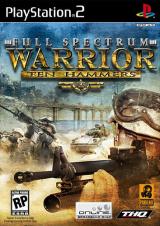For those of you who've earned your stripes in the first Full Spectrum Warrior, you'll feel right at home playing Ten Hammers. There aren't any real fundamental changes in the gameplay since the first game. But for all of you green recruits out there, a quick trip to boot camp will likely be in order. Those looking for the usual squad-based experience are in for a rude awakening.
Despite its FPS appearance, the game actually plays more like a real-time strategy game. This is because the game was originally designed to help train military leaders when giving orders during combat situations. Players don't actually have direct control over the characters in their squads, like in most other games of this type. Instead, players are on the sidelines, dishing out various commands to their fire teams, such as ordering the group to lay down cover fire, take up strategic positions, and cover key locations.

Though the game covers a lot of familiar territory, Ten Hammers is more than a simple rehash of the original FSW. Ten Hammers has improved on the original in many ways. The gameplay now includes a smoother control scheme, allowing the player to command as many as four separate fire teams. Players can also split up their teams for better coverage or to flank the enemy forces. Ten Hammers even allows players to take control of some major artillery, either by tooling around in an M2A2 Bradley tank or by calling in for help from above in the form of a precision air strike.
The gameplay isn't the only thing that has been improved. The presentation has been given a significant overhaul as well. The graphics are sharp and highly detailed. The visuals never faltered, regardless of how much action was going on at any given time. The sounds have also done a phenomenal job of complementing the games visuals, from the rumbling of the Bradley and the explosive thunder of grenades to the pops of gunfire and whizzing bullets flying through the air. The action taking place in this fictional Middle Eastern country looks and sounds as if it's been ripped straight from war footage of combat taking place in Iraq.





 Good
Good


